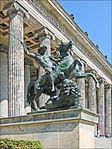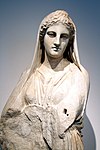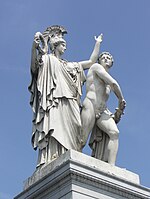Severan Tondo

The Severan Tondo or Berlin Tondo from circa 200 AD, is one of the few preserved examples of panel painting from Classical Antiquity, depicting the first two generations of the imperial Severan dynasty, whose members ruled the Roman Empire in the late 2nd and early 3rd centuries. It depicts the Roman emperor Septimius Severus (r. 193–211) with his wife, the augusta Julia Domna, and their two sons and co-augusti Caracalla (r. 198–217) and Geta (r. 209–211). The face of one of the two brothers has been deliberately erased, very likely as part of damnatio memoriae.On the viewer's right is Septimius Severus, and to the left Julia Domna. In front of them are the boys Caracalla and Geta, probably the figure with the erased face on the viewer's left and slightly to the rear of the other boy. All wear jeweled gold wreaths and imperial insignia, some details of which have been lost. The dating of the piece has caused some debate among scholars, with the final consensus being circa 200 AD. The tondo has many stylistic connections to Fayum Mummy portraiture including materials and artistic elements, and its production has been located in the Fayum district of Egypt during this period. Later on the tondo re-emerged from the antiquities trade; the provenance is unknown before entering the Antikensammlung Berlin (inventory number 31329) in the 20th century. It is now in the Altes Museum.
Excerpt from the Wikipedia article Severan Tondo (License: CC BY-SA 3.0, Authors, Images).Severan Tondo
Platz der Märzrevolution, Berlin Mitte
Geographical coordinates (GPS) Address Website Nearby Places Show on map
Geographical coordinates (GPS)
| Latitude | Longitude |
|---|---|
| N 52.519 ° | E 13.398 ° |
Address
Museumsinsel
Platz der Märzrevolution
10117 Berlin, Mitte
Germany
Open on Google Maps









